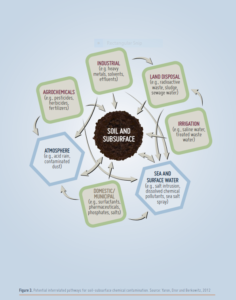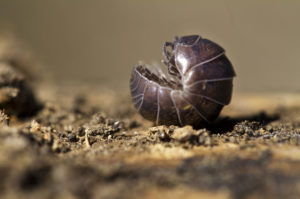Soil Pollution is Eroding our Soil and our Health
Soil pollution.
It’s often a topic we skirt over when discussing the health of our soils. Many of us aren’t even aware that it’s a problem.
But according to a 2018 report by the Food and Agriculture Organization (FAO), soil pollution is one of the main soil threats affecting global soils. Soil pollution, like many conventional agricultural practices, affects the soil’s ability to filter contaminants. It also reduces crop yields and contaminates the foods we eat, which can, in turn, make us sick.
While some soil pollution is naturally-occurring–such as pollution from forest fires and volcano eruptions–much of it is anthropogenic (man-made).
Sources of Soil Pollution
The main sources of anthropogenic soil pollution include:
- E-waste
- Industrial chemical byproducts
 Domestic chemical byproducts
Domestic chemical byproducts- Livestock byproducts
- Municipal waste
- Agrochemicals (fertilizer and pesticides)
- Petroleum
- Pollution from transportation
- Nuclear weapon byproducts
- Pharmaceuticals
- Mining
Each source of soil pollution plays an incredible role in the degradation of our soil. E-waste, or electronic waste, is a particularly concerning source of pollution. E-waste cannot be disposed of like normal waste because it contains toxic chemicals and elements. Rather than recycling this waste, we often just throw it away. Sitting in a landfill, these materials, like batteries, leach toxic chemicals into the soil.
We’ve known for years that industrial waste from factories contributes to eutrophication (water pollution), but we now know that it also contributes to soil pollution. Similarly, we know that agrochemicals (like fertilizers and pesticides) contribute to eutrophication, but many aren’t aware that they contaminate our soil as well.
Fertilizers are essential for growing crops. Without them, we would have smaller yields. Yet, farmers have been over-fertilizing their fields for decades, erroneously believing that more fertilizer would mean bigger yields. Unfortunately, things don’t work this way. Plants will only absorb as much as they need, so if you apply more fertilizer to your field, your plants won’t absorb it. Instead, the fertilizer will sit in the soil, where rain will wash it into nearby water resources via runoff or where soil microbes will release it into the atmosphere as a greenhouse gas.
In addition to this, salt- and chemical-heavy fertilizers will cause soil salinity and heavy metal contamination. According to the FAO, the fertilizer industry is responsible for introducing heavy metals–such as Hg, Cd, As, Pb, and Cu–to the soil.
So what are the effects of this pollution? Is it really a big deal?
Effects of Soil Pollution
Soil pollution is a big deal because it directly affects both the earth and people.
Soil pollution, first and foremost, affects the soil. Heavy metals can cause soil acidification, which not only affects plants, but also affects soil microbes. These microbes are responsible for improving soil structure, generating nutritious matter for plants, and helping soil retain water. When soil acidifies, it leads to erosion.
These contaminants also alter the soil’s nutrient content, which hinders plants’ ability to absorb nutrients and perform photosynthesis.
We might not realize it, but this is pretty important stuff. As of right now, 95% of the food we grow relies on topsoil–and 50% of this topsoil has been lost to erosion and soil degradation. While correcting harmful agricultural practices can reduce the amount of soil erosion and practicing regenerative agriculture can help restore the earth’s topsoil, we still need to correct the problem of soil pollution. Doing so will further reduce the amount and rate of soil erosion.
By reducing soil pollution, we’ll also be able to foster a healthier environment for our crops, which will lead to bigger yields.
Soil pollution doesn’t only affect soil, however; it also affects water and air. When soil is polluted with chemicals, metals, and salts, it leaches into groundwater and flows into rivers and streams. Contaminated groundwater is obviously bad for our health, but contaminated rivers pose a serious environmental threat. Eutrophication can deplete dissolved oxygen levels within the water, killing aquatic plant and animal life. It can also make water unsafe to swim in. Soil pollution also releases volatile compounds into the atmosphere, which can contribute to climate change and to our health.
And this brings us to how soil pollution affects human health.
How does Soil Pollution Affect Health?
According to the FAO, there are three human health risks associated with soil pollution:
- Elemental Contamination
- Organic Chemical Contamination
- Pharmaceutical Contamination
Humans are exposed to these contaminants either by touching the soil, breathing and drinking contaminated air and water, eating contaminated plants, or directly eating the soil (by not washing vegetables).
Cadmium and lead are two of the most toxic contaminants we consume due to soil pollution. In 1968, cadmium from a polluted river in Japan caused the itaí-itaí disease, characterized by spinal and joint pain. It was later found that cadmium poisoning caused kidney failure and the softening of bones. Lead affects our organs–including the liver, spleen, kidneys, and lungs–and causes neurotoxicity.
Other pollutants, such as mercury, arsenic, nickel, and zinc, can cause a variety of issues. Arsenic has been defined as carcinogenic, and its consumption can lead to skin cancer.
So, obviously, soil pollution can affect our health. The question is: what can we do to stop it?
Ending Soil Pollution
For centuries, we have treated the soil as a sink or garbage can. But we cannot continue to dump our waste into the earth.
The soil is essential for all life. It filters contaminants, provides nutrients for plants, stores carbon, and protects us from flooding. Without it, we would have nothing on which to live–nothing in which to grow our food.
Luckily, there are ways we can limit soil pollution. We can reduce chemical pollution from factory waste, transportation, petroleum, weapons, and medicine by introducing stricter regulations and cleaner disposal methods. As for the agricultural sector, we can limit pesticide use by using crop rotations and introducing natural predators. We can also switch to ecofriendly fertilizers, like xVital.
xVital is a salt-free, chemical-free fertilizer made of just two ingredients: ionized water and nitrate. Unlike other fertilizers, it doesn’t introduce chemicals, heavy metals, or salts into the soil. In addition, it does not contribute to runoff. Therefore, it won’t pollute the soil, water, or air.
Of course, preventative measures won’t be enough to reduce soil pollution.
We need a way to heal the soil, because if we leave the chemicals in the soil, they’ll only build up. Luckily, there is a solution.
Rollie Pollie Remediation
As previously mentioned, farmers aren’t simply correcting harmful farming practices; they’re turning to regenerative agriculture in order to heal the soil.

So instead of just correcting soil pollution, we should also be working to heal the soil that has already been polluted.
According to a 2019 study, there is an “insect” that can actually absorb heavy metals from the soil: rollie pollies. These “insects,” which are actually crustaceans, possess gut microbes that crystallize heavy metals. For this reason, rollie pollies can survive in soil so contaminated that other creatures cannot.
By introducing rollie pollies to contaminated soil, we can help regenerate this soil so it can once again be used for cropland. Then, of course, preventative measures must be taken to ensure the soil stays clean.
There are other more technical ways to remediate the soil, as defined by the FAO. You can read more about them here.
Sources:
Study Finds ‘Rollie Pollies’ Remove Heavy Metals From Soil, Protects Groundwater

